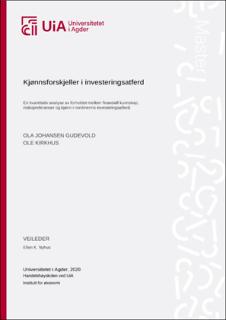| dc.contributor.author | Gudevold, Ola Johansen | |
| dc.contributor.author | Kirkhus, Ole | |
| dc.date.accessioned | 2020-09-25T08:30:00Z | |
| dc.date.available | 2020-09-25T08:30:00Z | |
| dc.date.issued | 2020 | |
| dc.identifier.citation | Gudevold, O.J. & Kirkhus, O. (2020) Kjønnsforskjeller i investeringsatferd. En kvantitativ analyse av forholdet mellom finansiell kunn skap kap, risikopreferanser og kjønn i nordmenns investeringsatferd (Master¨s thesis). University of Agder, Kristiansand kap, risikofaktorer og kjønn i nordmenns investeringsadferd kap (Master´s thesis). University of Agder, Kristiansandkap, risikopreferanser og kjønn i nordmenns investeringsatferd. | en_US |
| dc.identifier.uri | https://hdl.handle.net/11250/2679603 | |
| dc.description | Master´s thesis in Business Administration (BE501) | en_US |
| dc.description.abstract | The purpose of this thesis was to examine gender differences in Norwegians’ investment behavior in conjunction with financial literacy and willingness to take risk. The thesis is based on survey results from TNS Gallup regarding financial behavior and literacy. The survey was carried out on Norwegians from age 18-89 in June 2017. 2209 participants replied to the survey.The results show a significant positive covariance for investing in the stock market with all the three independent variables: financial literacy, willingness to take risk and gender. Willingness to take risk was the variable that posed the strongest explanatory power for variation within investment decisions, including stocks, mutual funds, bonds, certificate of deposits, deposit accounts and valuable assets such as jewelry, gold, diamonds, art, watches, etc. This emphasizes the importance of a deeper understanding of the gender gap within investing and that it is not sufficient to focus on only the financial literacy in women.The results showed as expected a significant gender difference in financial literacy and willingness to take risk, where as women have a lower financial literacy and are more risk averse than men. Gender still amounted to a significant variable after it was controlled for financial literacy, willingness to take risk and other demographic variables such as age, education, income, etc. This indicates that there are more underlying variables that should be identified and more closely examined. Keywords: Gender differences, investing, financial literacy, willingness to take risk, gender gap, she invests, equality. | en_US |
| dc.language.iso | nob | en_US |
| dc.publisher | University of Agder | en_US |
| dc.rights | Attribution-NonCommercial-NoDerivatives 4.0 Internasjonal | * |
| dc.rights | Attribution-NonCommercial-NoDerivatives 4.0 Internasjonal | * |
| dc.rights.uri | http://creativecommons.org/licenses/by-nc-nd/4.0/deed.no | * |
| dc.subject | BE501 | en_US |
| dc.title | Kjønnsforskjeller i investeringsatferd En kvantitativ analyse av forholdet mellom finansiell kunnskap, risikopreferanser og kjønn i nordmenns investeringsatferd. | en_US |
| dc.type | Master thesis | en_US |
| dc.rights.holder | © 2020 Ola Johansen Gudevold & Ole Kirkhus | en_US |
| dc.subject.nsi | VDP::Samfunnsvitenskap: 200::Økonomi: 210::Samfunnsøkonomi: 212 | en_US |
| dc.source.pagenumber | 66 | en_US |

